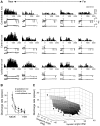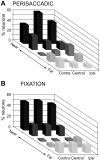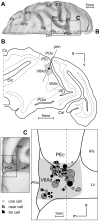Fix your eyes in the space you could reach: neurons in the macaque medial parietal cortex prefer gaze positions in peripersonal space
- PMID: 21858075
- PMCID: PMC3157346
- DOI: 10.1371/journal.pone.0023335
Fix your eyes in the space you could reach: neurons in the macaque medial parietal cortex prefer gaze positions in peripersonal space
Abstract
Interacting in the peripersonal space requires coordinated arm and eye movements to visual targets in depth. In primates, the medial posterior parietal cortex (PPC) represents a crucial node in the process of visual-to-motor signal transformations. The medial PPC area V6A is a key region engaged in the control of these processes because it jointly processes visual information, eye position and arm movement related signals. However, to date, there is no evidence in the medial PPC of spatial encoding in three dimensions. Here, using single neuron recordings in behaving macaques, we studied the neural signals related to binocular eye position in a task that required the monkeys to perform saccades and fixate targets at different locations in peripersonal and extrapersonal space. A significant proportion of neurons were modulated by both gaze direction and depth, i.e., by the location of the foveated target in 3D space. The population activity of these neurons displayed a strong preference for peripersonal space in a time interval around the saccade that preceded fixation and during fixation as well. This preference for targets within reaching distance during both target capturing and fixation suggests that binocular eye position signals are implemented functionally in V6A to support its role in reaching and grasping.
Conflict of interest statement
Figures








Similar articles
-
Reaching activity in parietal area V6A of macaque: eye influence on arm activity or retinocentric coding of reaching movements?Eur J Neurosci. 2008 Feb;27(3):775-89. doi: 10.1111/j.1460-9568.2008.06021.x. Eur J Neurosci. 2008. PMID: 18279330 Free PMC article.
-
Evidence for both reaching and grasping activity in the medial parieto-occipital cortex of the macaque.Eur J Neurosci. 2004 Nov;20(9):2457-66. doi: 10.1111/j.1460-9568.2004.03697.x. Eur J Neurosci. 2004. PMID: 15525286
-
Body-centered, mixed, but not hand-centered coding of visual targets in the medial posterior parietal cortex during reaches in 3D space.Cereb Cortex. 2014 Dec;24(12):3209-20. doi: 10.1093/cercor/bht181. Epub 2013 Jul 12. Cereb Cortex. 2014. PMID: 23853212
-
Human cortical areas underlying the perception of optic flow: brain imaging studies.Int Rev Neurobiol. 2000;44:269-92. doi: 10.1016/s0074-7742(08)60746-1. Int Rev Neurobiol. 2000. PMID: 10605650 Review.
-
Progress in understanding spatial coordinate systems in the primate brain.Neuron. 2006 Jul 6;51(1):7-9. doi: 10.1016/j.neuron.2006.06.011. Neuron. 2006. PMID: 16815326 Review.
Cited by
-
Simulating the cortical 3D visuomotor transformation of reach depth.PLoS One. 2012;7(7):e41241. doi: 10.1371/journal.pone.0041241. Epub 2012 Jul 16. PLoS One. 2012. PMID: 22815979 Free PMC article.
-
Are reaching and grasping effector-independent? Similarities and differences in reaching and grasping kinematics between the hand and foot.Exp Brain Res. 2022 Jun;240(6):1833-1848. doi: 10.1007/s00221-022-06359-x. Epub 2022 Apr 15. Exp Brain Res. 2022. PMID: 35426511 Free PMC article.
-
Functional Neuroanatomy of the Human Accommodation Response to an "E" Target Varying from -3 to -6 Diopters.Front Integr Neurosci. 2020 May 21;14:29. doi: 10.3389/fnint.2020.00029. eCollection 2020. Front Integr Neurosci. 2020. PMID: 32508603 Free PMC article.
-
Binocular advantage for prehension movements performed in visually enriched environments requiring visual search.Front Hum Neurosci. 2014 Nov 28;8:959. doi: 10.3389/fnhum.2014.00959. eCollection 2014. Front Hum Neurosci. 2014. PMID: 25506323 Free PMC article.
-
Flexible Reference Frames for Grasp Planning in Human Parietofrontal Cortex.eNeuro. 2015 Jun 24;2(3):ENEURO.0008-15.2015. doi: 10.1523/ENEURO.0008-15.2015. eCollection 2015 May-Jun. eNeuro. 2015. PMID: 26464989 Free PMC article.
References
-
- Critchley M. Tactile thought, with special reference to the blind. Brain. 1953;76:19–35. - PubMed
-
- Perenin MT, Vighetto A. Optic ataxia: a specific disruption in visuomotor mechanisms. I. Different aspects of the deficit in reaching for objects. Brain. 1988;111(Pt 3):643–674. - PubMed
-
- Baylis GC, Baylis LL. Visually misguided reaching in Balint's syndrome. Neuropsychologia. 2001;39:865–875. - PubMed
-
- Danckert J, Goldberg L, Broderick C. Damage to superior parietal cortex impairs pointing in the sagittal plane. Exp Brain Res. 2009;195:183–191. - PubMed
Publication types
MeSH terms
LinkOut - more resources
Full Text Sources

